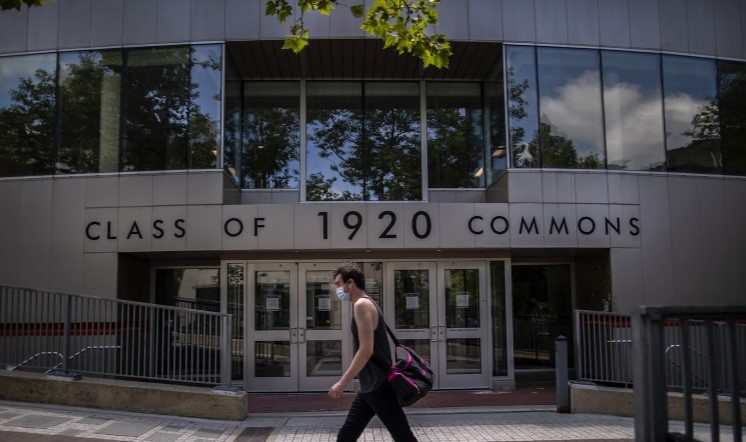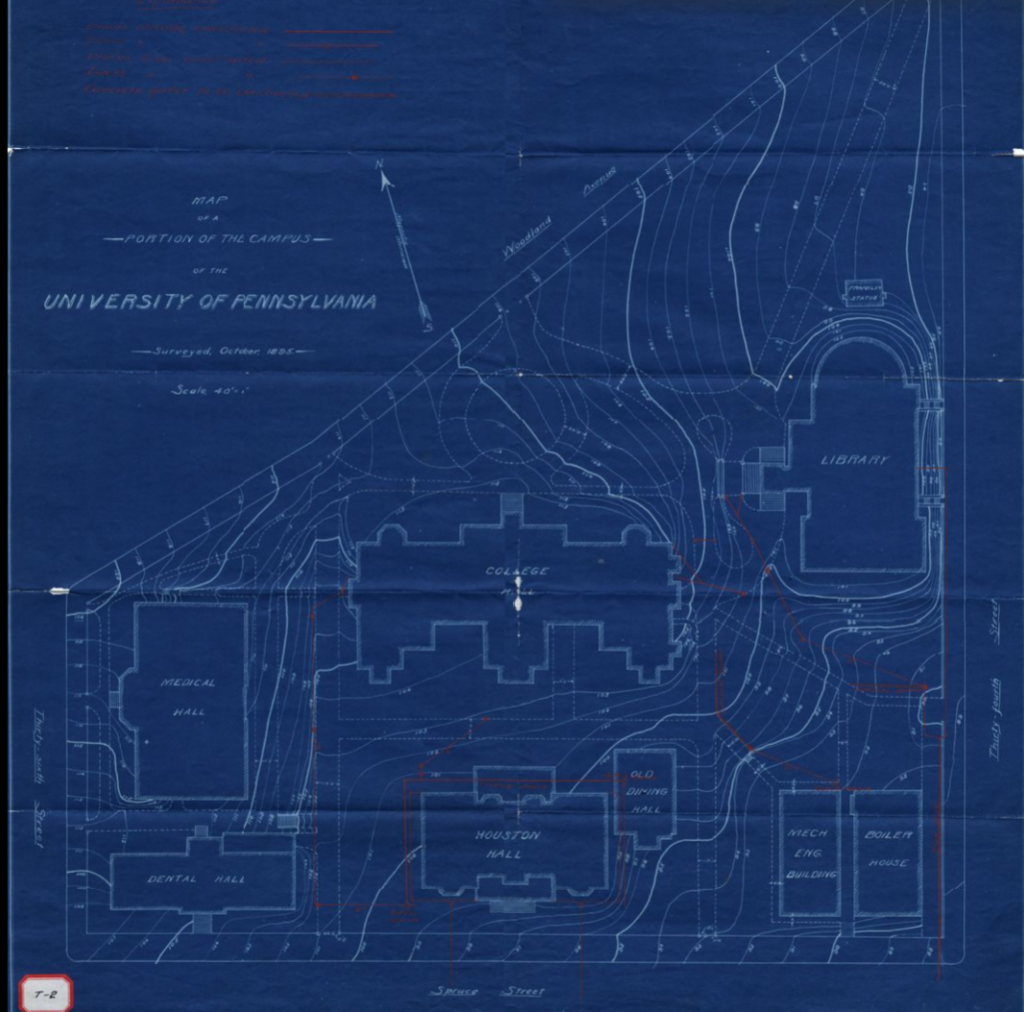1920 Commons Dining Hall / Photo credit: Penn Dining
By Anjali Reddy
Editor’s Note: This piece is part of a series. As a part of this series, we plan to release pieces on outsourcing dining, unions and work conditions for employees, sustainability, pricing, and the quality and health of food in the coming weeks. If you have any additional ideas about aspects of Penn Dining you would like to better understand, or if you have responses to these pieces, please email anjalire@sas.upenn.edu. Be sure to sign up for our newsletter to be the first to hear when we release the next part.
From a million-dollar deficit to dining service strikes to outsourcing dining, Penn Dining has undergone many changes to become the dining program it is today. See a sneak peek at the first investigative reporting project of The Pennsylvania Post, aiming to answer the simple question: Why is Penn Dining so bad?
January 1896 — Houston Hall opens for the first time with a swimming pool, a pool table, a reading room, a theater, and a dining hall on the second floor.
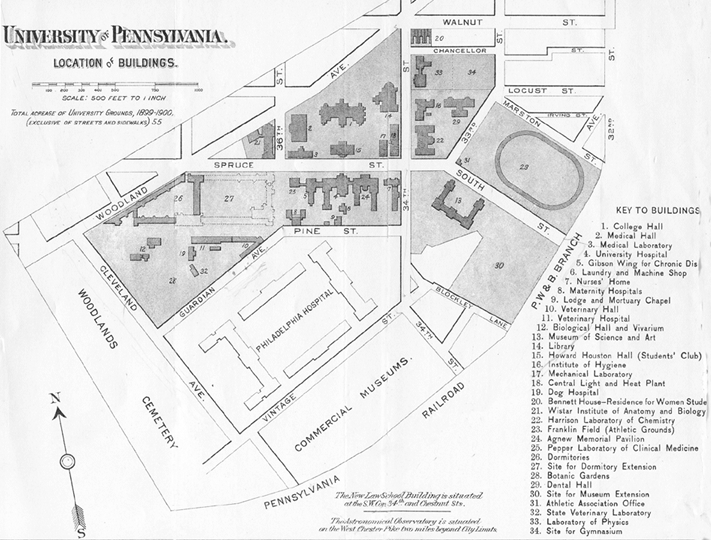
May 1961 — A house plan for what is now the Quad gets approved to house 250 to 300 undergraduate men with its own dining commons.
December 1964 — President Harnwell plans to create a dining commons in every residential living space in the University’s Integrated Development Plan because a dining commons within each house would encourage “an environment for learning.”
December 1964 — A new house plan hopes to create five residence houses each with their own dining rooms.
October 1967 — Amid a rise in student protests on college campuses in the 1960s, Philosophy Chairman and Professor Dr. James F. Ross said “A real undergraduate community will eventually have to have its physical plant, its housing, its dining, and its library facilities patterned appropriately for an autonomous community.”
October 1968 — During a $40 million construction of new facilities, the University plans to build the high rises and a new dining hall on 38th and Locust, now called 1920 Commons.
May 10, 1971 — The dining service workers—paid $1.59 per hour, the equivalent of $12.11 per hour today—go on strike. The dining services went on strike because 96 out of 155 people were “laid off” during the summer months. This amounted to a yearly salary of less than $3,300 per year, $25,094 today. Furthermore, they did not receive health insurance benefits for their families. The University responded by saying the workers were actually paid $1.74 per hour and 0.15 meal credits per hour for a total of $2.35 per hour. Additionally, within their contract, dining service employees agreed to “seasonal layoffs” because of decreased enrollment during the summer months.
May 12, 1971 — On May 11, 1971, the University and the Union agreed to settle the dining services strike, which was supported by library employees. The terms they agreed to included 1) keeping Hill dining open five days a week during the summer for lunch and dinner with 40 employees; 2) keeping Houston Hall, including the main dining hall, the balcony dining hall, and the Grille, open five days a week for breakfast and lunch with 55 employees; 3) the University consulting with representatives of the Union to decide on summer employment hours; 4) the University paying laid off dining service workers; 5) the University making an effort to find employment for employees laid off in the summer. These terms would be in effect provided that dining and library staff would return to work the following day. Finally, the University couldn’t take any “recriminatory action against members of Local No. 54 or Local No. 590, students, faculty or any other persons acting in concert with the said Locals for their participation in the strike of the University’s dining service employees.”
June 16, 1972 — The University announces all dining halls except for Hill Hall, 1920 Commons, and Stouffer will permanently close for “economic” reasons beginning in September. During the 1971-72 academic year, the dining facilities could serve 18,500 meals per day, during which costs surmounted revenue by $1,000,000. Now, the dining facilities would be able to serve 12,500 meals a day, still expected to exceed demand. This change was expected to cut the loss down to $500,000, affecting 45 of the 197 hourly dining employees and eight of the 27 supervisory personnel, all of whom were expected to receive “alternative job offers,” not layoffs.
September 1972 — Amid the University’s million-dollar Dining Services deficit, dining services went on strike again. As a part of the negotiation, the University agreed to resume services at the Law School, where several vending machines had been installed to replace the dining hall. Of the 35 affected employees, 16 served the Law School dining hall and 19 were reassigned to other university jobs.
September 1974 — Full dining services resumed in all six locations—Hill Hall, Hill Hall Snack Shop, Stouffer, Houston Hall Snack Bar, Law School, 1920 Dining Commons. Breakfast begins at 7:30 a.m. Dinner is served until 6:45 p.m.
September 1974 — Edward M. Grant becomes the new Dining Services director.
October 1974 — As the Quad undergoes renovations, the University plans for Quad residents to dine at Stouffer House. Part of the renovations include transforming the underused McClelland Lounge into “a center for inter-house activities” by including “studio space, crafts workshop, a small gym[,] and snack bar.”
October 1975 — Dining services go on strike again. As a result, the University allows students to receive refunds while only the snack bars in Hill and Houston are open from 10:00 a.m. to 3:00 p.m. on weekdays.
November 1975 — Following six weeks of striking, dining and library services return after the University agrees to a 6% increase on January 1 and another 6% increase on November 15 as well as group life insurance premiums.
January 1978 — Created by Director of Dining Services Don Jacobs, the Soupery opened in 1920 Commons. The location hosts a salad bar and serves soups, breads, quiches, juices, and coffee.
June 1980 — University Dining Services breaks even after working to reduce its million-dollar deficit since the 1970s (See figure below).
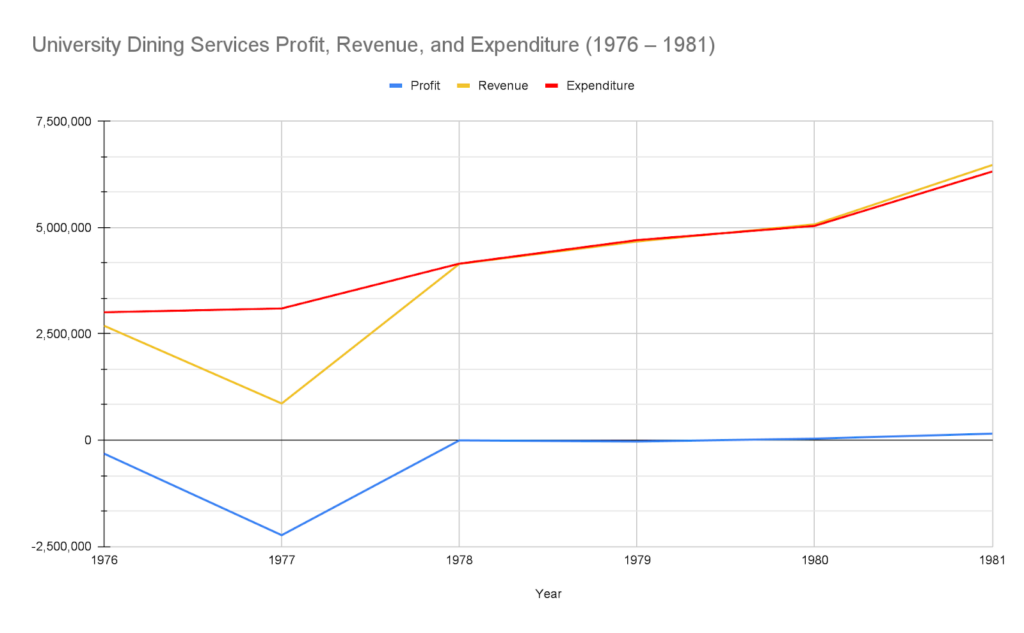
November 1992 — In the “Residential Planning for the 21st Century at the University of Pennsylvania,” the University notes that only Hill, King’s Court/English House, the first-year program in Harnwell, and the Castle, have “dedicated dining sites”, which “are the glue that cements community, offering consistent and recurring opportunities for house members to gather socially, intellectually or academically.” As a part of this plan for the next century, the University hopes to create dining halls for each house so “individual houses could eat together with some coherent identity.”
September 1996 — The University examines the possibility of outsourcing dining, hoping to find “opportunities to improve the quality and selection of food, enhance the service environment, and contain or reduce the cost of the Dining program.”
January 1997 — The University pilots serve food until 2:00 a.m. in Stouffer Dining Commons per the recommendation of students.
March 1997 — This summary of a study of food services at the University said that the University Dining and Hospitality Services, with its four dining halls, has operated on a break-even basis since the 1970s. Houston Hall, which contracted retail outlets like Burger King who rented out the space, generates revenue but is described as “uninspired” by students. Penn Dining was considered among the best college dining services receiving the Silver Plate award in the 1980s.
March 1997 — The University plans to partner with Bon Appétit to “provid[e] great food…. at a reasonable price.”
March 1997 — McClelland Market opens with three installations: Tomassito’s Italian Cafe, Block & Barrel Deli, and Deb’s Concessions. On weekdays, the Market opened from 8:00 p.m. to 2:00 a.m. and on weekends, the Market opened at noon.
September 1997 — “Prof to Lunch” becomes a year-round program where students could take their professors to lunch for $7.
November 1998 — The University plans to renovate Hill College House Kitchen, Servery, Dining Area (Summer 1999), Class of 1920 Commons (2000-2001), and Stouffer College House and Dining (2001-2003) to make “dining halls suitable for 21st Century living and learning.”
May 1999 — As a part of the Housing and Dining Renewal Project, the University tasked several firms with designing Hamilton Village, the part of campus that now includes the high rises Harnwell, Harrison, and Rodin. This project also included plans to make dining rooms for each high rise in Hamilton Village.
May 1999 — By outsourcing dining services to Bon Appétit Management Company (BAMCO), three of the Penn Dining Services managerial staff retained their roles while BAMCO interviewed candidates to fill the 17 remaining spots. Bon Appétit would gain “direct control over the purchase of food, hiring and training of staff.”
September 1999 — Irv’s Place, a new kosher dining restaurant, opens on 4051 Irving Street in partnership with Penn Hillel. The restaurant is under a Campus Dining Services contract but is managed by Flik International Corporation.
January 2000 — After the Undergraduate Assembly conducted a dining survey receiving 1,000 student responses out of 6,000, Dining Services extended the closing time from 8:00 p.m. to 9:00 p.m. and increased the number of vegetarian options.
September 2000 — Houston Hall opens with new food options. Houston Bistro, next to the Hall of Flags, hosts a “pub-style menu.” Houston Market includes—Blaze, a sandwich and burger place; Ciao, a pizza place; Global Fusion; The Wall, a salad place; and Pronto, a bakery.
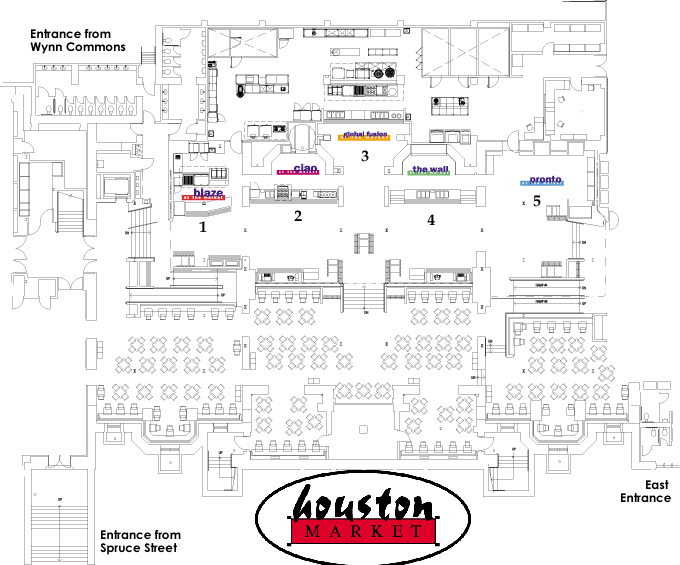
April 2002 — Construction for Steinhardt Hall begins and becomes the new home of Penn Hillel and the Kosher Dining Commons.
June 2002 — Penn Dining switches from BAMCO to Aramark under a one year contract for its outsourcing of dining due to “financial challenges and a different market direction.” Penn hopes to “reevaluate its all-you-care-to-eat offerings and consider other opportunities to add flexibility, improve quality and innovate its campus dining program.”
September 2003 — Aramark signs an additional two year contract with Penn with the possibility of four more two-year contracts. They will manage student dining services, Houston Market, the 1920 Commons convenience store, and the kosher dining in Penn Hillel. Aramark also plans to create several new retail dining spaces: a coffee cafe in Towne; the Noodle Bar, replacing the Global Fusion place in Houston; and Mark’s Cafe on the ground floor of Van Pelt Library.
January 2007 — Penn Dining gets rid of trans fats in the dining halls after Aramark conducts research showing that consumers are more worried about eating trans fats than ever before.
July 2009 — Penn returns to outsourcing dining to BAMCO because of its “culinary expertise” and as a “pioneer in environmentally sound food policies.” BAMCO has a Farm to Fork program, encouraging local food sourcing from farmers and businesses. BAMCO is “a key partner in support of the University’s Climate Action Plan.”
December 2009 — Michael Levenstein C ’13 expresses his concern for food waste and fiscal loss with some dining plans in a University Council Meeting.
February 2011 — Plans are in the works for McClelland Dining to undergo $1.5 million in renovations.
September 2012 — 1920 Commons undergoes a $6.5 million renovation, adding Starbucks, Gourmet Grocer, and an outdoor patio.
November 2013 — Tortas Fronteras opens in the ARCH, serving Mexican food.
August 2017 — Renovations of Hill College House expand its dining facilities by 50%.
August 2017 — Penn becomes the first U.S. college campus to have a Pret a Manger in a partnership between Pret a Manger, the University, and BAMCO.
Summer 2018 — Houston Hall closes for renovations to improve its kitchen and seating facilities.
May 2019 — Tortas Frontera closes due to a “changing food landscape on campus and dining’s need to constantly recalibrate its offerings based on evolving needs of the Penn Community”
May 2019 — Penn becomes the first in the Ivy League to complete The Healthier Campus Initiative of the Partnership for a Healthier America (PHA) by making 23 policy changes over three years to “improve nutrition, physical activity, sustainability and overall wellness.”
March 2020 — During the COVID-19 pandemic, BAMCO laid off around 140 dining employees. A petition started on change.org by the Student Labor Action Project, asking Penn and BAMCO not to lay off these workers, received 8,322 signatures. In response, Penn used emergency funds from grant money to pay eligible workers $1,500 of tax-free money. Eligible employees meant those who made below $70,000 a year.
February 2023: Following numerous health code violations at Hill Dining and 1920 Commons, Penn, and BAMCO responded by explaining the steps that had been taken to remediate these violations. At Hill Dining, the University set up traps for fruit flies, deep-cleaned areas beneath and behind large equipment, and worked with Northeast Extermination for pest control.
Anjali Reddy is a freshman in the College studying Economics and Cognitive Science from Newton, MA. Anjali is also the Data Editor for The Pennsylvania Post. Her email is anjalire@sas.upenn.edu.

